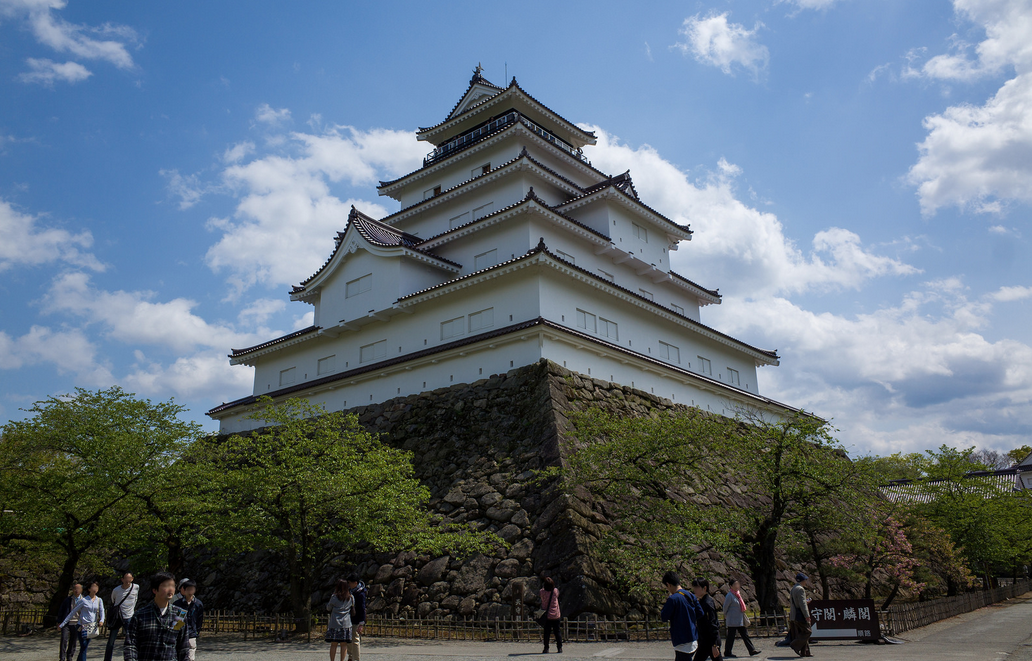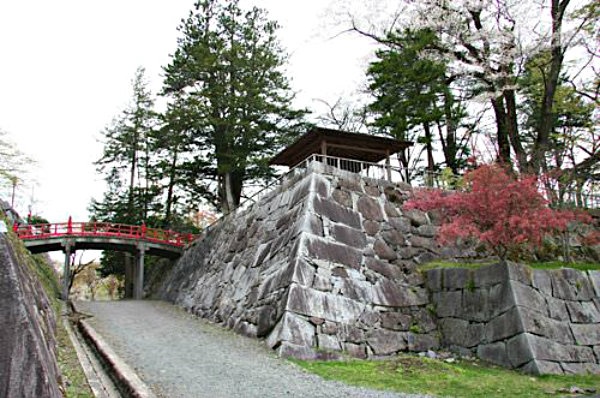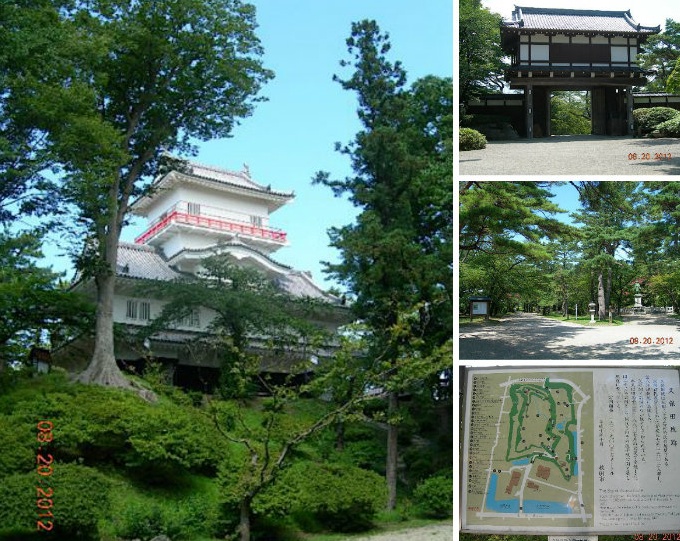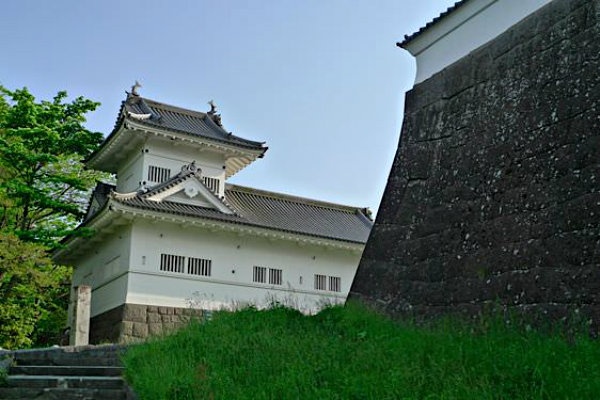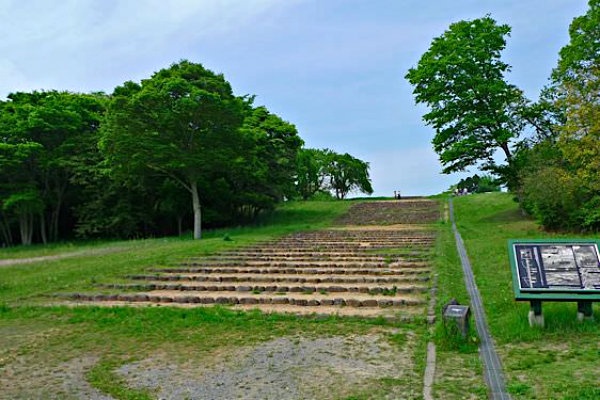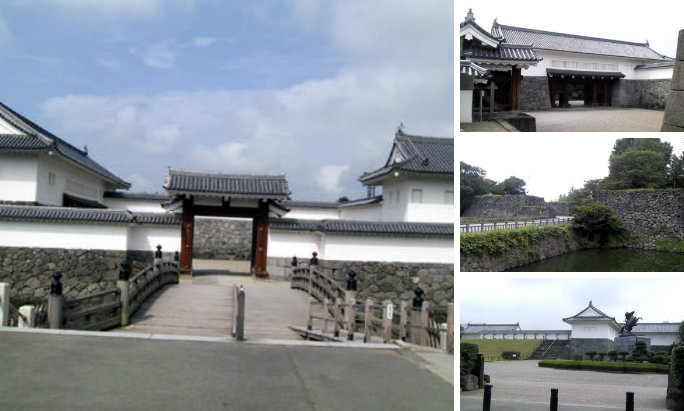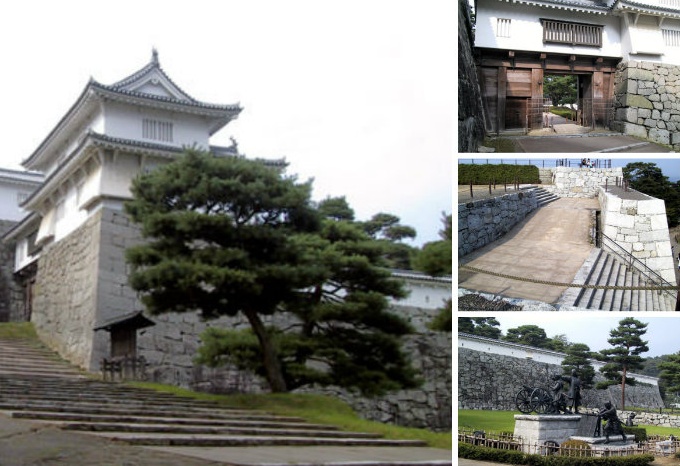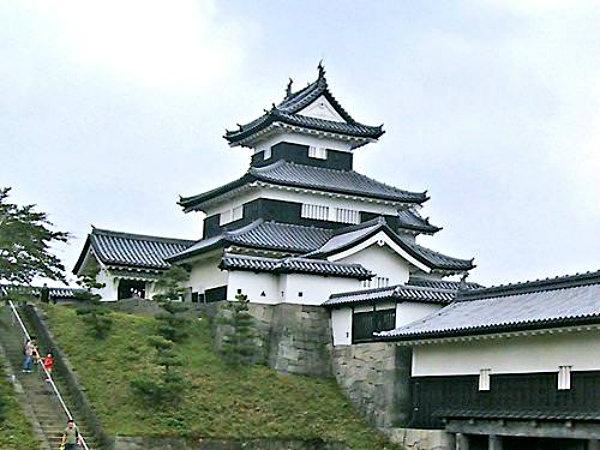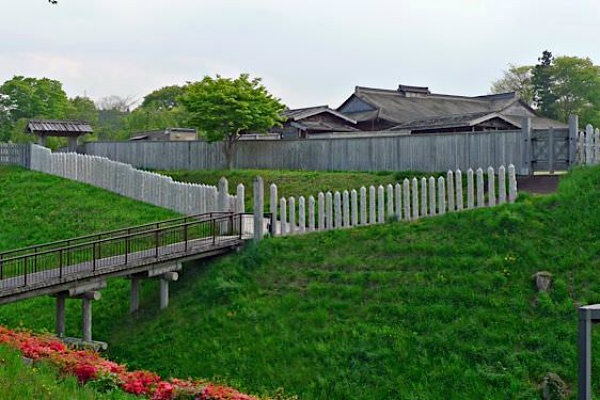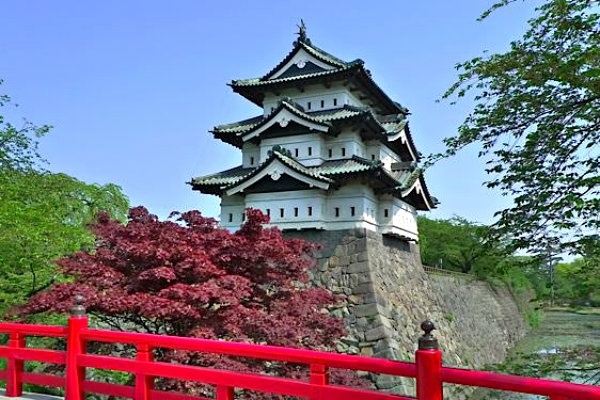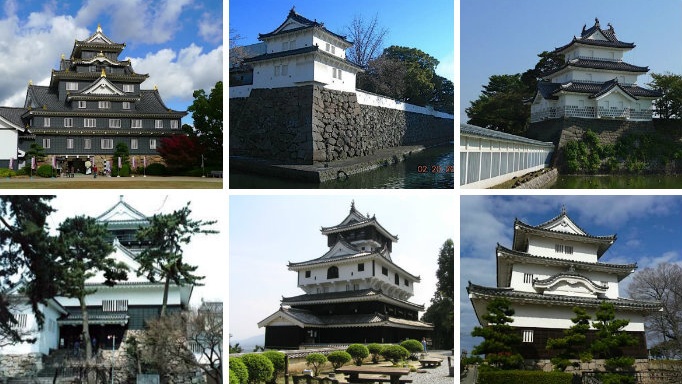Top 10 Castles in Tohoku
In 2006, the Japan Castle Foundation released a list of the Top 100 castles in Japan. Selection was based on important cultural or historical artifacts, settings for important historical events, and representative castles from each historical period and region, with at least one castle chosen from each prefecture. These are the best of Tohoku.
By Jcastle10. Morioka Castle (Morioka City, Iwate, ☆☆)
Nanbu Nobunao, lord of Fukuoka Castle in Kunohe Village, Iwate, founded Morioka Castle to better control the important riverways of the Kitakami and Nakatsu Rivers.
Unfortunately, Nobunao died before finishing construction, and the castle was completed by his son Shigenao in 1633. The Nanbu family retained control over this castle for the entire Edo Period (1603-1868) until the coming of the Meiji Restoration in 1868.
Today, the castle is a ruin, though you can find some remaining stonework and walls in and around the honmaru (main bailey). Most of the location is currently a park.
9. Kubota Castle (Akita City, Akita, ☆☆)
Satake Yoshinobu was moved from the Mito area to Akita after the Battle of Sekigahara (1600). He built Kubota Castle in 1604.
It's said that Yoshinobu never built a main keep or any three-level yagura (turret) so he wouldn't attract the ire of the Tokugawa. However, Mito Castle had no main keep nor any large yagura either, so another theory is that he just couldn't afford an extravagant main keep. Even so, the design and foundation of the castle made it a strong fortification. Nonetheless, most of the buildings burned down in a fire in 1880.
The castle is well known for being mainly built from large earthen embankments. There's very little stonework, and what exists is there mainly to fortify some of the bailey foundations. You can still see several of the yagura foundations even though no structures remain today, though a corner turret was reconstructed in 1989, as well as the front gate in 2001.
8. Sendai Castle (Sendai City, Miyagi, ☆☆)
Date Masamune received increased lands around Sendai for giving his support to Tokugawa Ieyasu in the Battle of Sekigahara. One of the most interesting figures of his time period, Masamune was known as the "One-Eyed Dragon" (he lost the use of his right eye to smallpox). He was feared by Toyotomi Hideyoshi, and later became a deputy shogun in the Tokugawa regime.
Masamune actively promoted culture and industry. He built Osaki Hachiman Shrine in Sendai and Zuiganji Temple in Matsushima. He organized improvements to the rivers and forests, and transformed the Osaki Plain into a fertile rice field. Masamune also built a ship and dispatched his own men, including Hasekura Tsunenaga, to the Pope in Rome.
Sendai Castle (also known as Aoba Castle) never had a large main keep like many castles of its time. There are various theories why, and there's some proof that there were plans to build a large five-story keep that was never constructed. Even without a large main keep, it was still an impressive castle, with three three-story yagura (turrets) and a great honmaru (central bailey) palace. Date Tadamune, Masamune's second son, added the ninomaru (second bailey) after he became lord of Sendai.
After the Boshin War (1868-1869), the honmaru was torn down. During a fire in 1882, most of the ninomaru was burned to the ground, and the remaining buildings of the castle were destroyed during the bombings of World War II.
As a result, there's not much left at the main site today. The otemon guardhouse in the picture above is a fair distance (10+ minute walk) from the honmaru and on-site museum. Either find it on a map or ask for directions at the museum.
It's best to take the sightseeing bus to the main castle gate, visit the museum and grounds, and then walk downhill toward the guardhouse. Then you can get back on the sightseeing bus from the nearby Sendai City Museum.
7. Taga Castle (Tagajo City, Miyagi, ☆☆)
Taga Castle was built in the year 724 on the boundary between the Emishi people of the northeast and the lands ruled by the imperial court during the Nara (710-794) and early Heian Periods (794-1185). It was the main military and political base for the pacification of northeastern Japan.
It was burned down in a rebellion in 780, but was soon rebuilt. Sakanoue no Tamuramaro moved the military base farther north in 802, but Taga Castle continued to flourish as the political and administrative center. Taga Castle lost its importance during the South and North Courts Period (1334-1392), and now stands only as a ruin.
Several of castles of this same type were built, pushing further into the north as new territories were subjugated. Taga Castle is well known for being mentioned in the Shoku Nihonki, an ancient history text completed in 797, and centuries later by master poet Matsuo Basho in his famous Oku no Hosomichi (The Narrow Road to the Interior).
6. Yamagata Castle (Yamagata City, Yamagata, ☆☆)
The castle originally established by Shiba Kaneyori at Yamagata is said to have been about the size of the honmaru (central bailey) of the later Yamagata Castle.
Shiba later took the name of the surrounding area and changed his name to Mogami. His descendant, Mogami Yoshiaki, reconstructed the castle into a much larger fortress in 1592. He added the ninomaru (second bailey) and sannomaru (third bailey), but there was never a large main keep like those you see at other castles. It did, however, have three two-story yagura (turrets) and one three-story yagura.
While Mogami Yoshiaki went to the Battle of Sekigahara with Tokugawa Ieyasu in 1600, it's said that Naoe Kanetsugu went to attack Yamagata Castle, but he couldn't find it as it was buried in thick fog. Thereafter, the castle was also known as Kasumi-ga-jo, the castle in the haze.
At his peak after the battle of Sekigahara, Yoshiaki controlled land yielding 570,000 koku (where one koku was enough rice to feed one person for a year). Yoshiaki died in 1614, and his successor Iechika died shortly thereafter in 1617. Over time, the importance of Yamagata Castle to the Tokugawa rule over eastern Japan declined, and with it, the size of territory controlled by the lord of Yamagata Castle was also reduced.
Yamagata Castle is well known today for the authentic wooden reconstruction of the East Gate. As you can see from the above picture, this is a compound masugata-style gate. The two tamon yagura (stretched towers), the high stone-walled moat, and the walls surrounding the top make it quite impregnable.
5. Nihonmatsu Castle (Nihonmatsu City, Fukushima, ☆☆)
This castle, also known as Kasumi-ga-jo (there were quite a few "mist castles"), actually encompasses two different castles. At the top of the hill are the remnants of the original castle built by the Hatakeyama Clan somewhere between 1394 and 1427 (the exact date is unknown), and at the base of the hill are the remnants of the castle built by the Niwa Clan in the 17th century. Each of these castles experienced its own separate demise.
Hatakeyama Yoshitsugu captured Date Terumune, Date Masamune's father, in 1585, and tried to take him back to Nihonmatsu. Upon hearing this, Masamune, who was out hunting, took off on his horse and caught up with Yoshitsugu near the Abukuma River, in the vicinity of Nihonmatsu Castle. He and his men shot the whole party dead, and Terumune was killed in the struggle.
Hearing of the weakness of Nihonmatsu, a group of samurai from Hitachi Province (now Ibaraki Prefecture), including men from the Satake, Ashina, Iwaki and Ishikawa Clans, set out to take Nihonmatsu for themselves. They clashed with the Date forces near present-day Motomiya (between Koriyama and Nihonmatsu). This was known as the battle of Hitotoribashi. The battle ended in a standstill, and Nihonmatsu Castle stood independent from both forces.
In April of the following year (1586), Date Masamune's forces once again laid seige to the castle. In July, the son of Hatakeyama Yoshitsugu set fire to the castle and fled to Aizu. Thus the original castle at Nihonmatsu met demise.
The second castle was built at the base of the hill and controlled by various families loyal to the Date, with the Niwa clan controlling it from 1643 until the Meiji Restoration (1868).
The honmaru (central bailey) and its stone walls sit on top of the mountain a short hike from the reconstructed Minowa Gate you see in the picture above. It's definitely worth the trip up to see not only this, but the awesome view of the surrounding area. The Chrysanthemum Festival, which begins in October and runs into November, is also quite impressive.
4. Shirakawa Castle (Shirakawa City, Fukushima, ☆☆☆)
Shirakawa Castle, also known as Komine Castle, was originally built by the Yuki Clan in 1340. They were dispossessed by Toyotomi Hideyoshi in 1590, and the castle passed through the hands of a number of daimyo during the Edo Period (1603-1868).
In 1627, it was taken over by Niwa Nagashige, who renovated it and renamed it Shirakawa Castle. The Tokugawa finally took direct control of the castle in 1866, but it was essentially destroyed during fighting against pro-imperial forces in the Boshin War (1868-1869).
The moats and walls around this castle are very well preserved; if you're in the area it's definitely worth a stop. Walk around the full outside of the castle to see the stone walls. Reconstructed in 1991, the main keep is also very well rebuilt.
3. Aizu-Wakamatsu Castle (Aizu-Wakamatsu City, Fukushima, ☆☆☆)
Aizu-Wakamatsu Castle (also known as Tsuruga Castle) was the strongest fortress in all of Tohoku. It was originally built in 1384 as Kurokawa Castle by Ashina Naomori.
In 1589, Date Masamune defeated Ashina Yoshihiro and moved into Kurokawa Castle. A year later, it was absorbed by Toyotomi Hideyoshi and subsequently governed by Gamo Ujisato. Gamo renovated the castle and renamed it Tsuruga Castle. The reconstructed main keep you see today is a 1965 reconstruction based on Gamo's design.
After the establishment of the Tokugawa Shogunate, the castle was governed by the Matsudaira Clan. The Matsudaira were a branch of the Tokugawa family, and thus in the category of "inner lords." The inner lords were branches of the Tokugawa family who kept watch over the daimyo who were not originally Tokugawa allies, and thus provided a buffer between allied and non-allied daimyo.
The Matsudaira ruled from Tsuruga Castle until the Meiji Restoration (1868), when the castle fell in the Boshin War. The most famous episode from the downfall of Tsuruga Castle is that of the Byakkotai ("White Tiger Company"), a group of 19 young samurai who committed suicide on nearby Mount Iimori when they saw smoke rising from the town, and assumed the castle had fallen.
The layout of this castle was patterned after that of Osaka Castle during Toyotomi Hideyoshi's time. The gray roofing tiles were all replaced between 2010 and 2011 with reddish tiles to match the original construction. The castle has many great moats and stone walls, so it's worth taking the time to walk the grounds.
2. Ne Castle (Hachinohe City, Aomori, ☆☆☆☆)
Ne Castle is from the time period before the flourishing of castle construction, so it's a little bit different from what you might expect. There are still gates, baileys and watchtowers, but there is no main keep, little to no stonework, and the walls are wooden post fences on the outside and slatted wooden walls in the central compound.
Moroyuki Nanbu built Ne Castle in 1334 during the period known as the Northern and Southern Courts Period. Under allegiance to the Southern Court, Nanbu established Ne Castle to become the center of imperial government in the area. Another branch of the same Nanbu family actually ruled the Sannohe and Morioka area for the Northern Court at the same time. In 1393, at the end of this Northern and Southen Courts period, the two families also made peace with each other.
The reconstructed buildings at Ne Castle are really fantastic. They were all done using original materials and techniques. Archaeological excavations uncovered the locations for the pillars and walls of each building, and found enough artifacts to understand the function of each. What we don't know for sure is how each building was made, so the park has reconstructed a variety of different building types and roof types to be representative of the architecture at that time.
The signs are all in Japanese, but they often have very good illustrations that help you understand without the explanation.
If you can speak even some Japanese, ask one of the volunteer guides at the gate to go with you. They're a wealth of knowledge about the history of the castle, the excavations, and trivia about the different building techniques and types. Ne Castle is highly recommended for history, castle or architecture fans.
1. Hirosaki Castle (Hirosaki City, Aomori, ☆☆☆☆☆)
Oura Tamenobu was awarded the area around Hirosaki for his loyalty to Toyotomi Hideyoshi during the Siege of Odawara (1590). He changed his name to to Tsugaru and started work on Hirosaki Castle in 1603.
He died in 1604, and work on the castle was put on hold until his son, Tsugaru Nobuhira, restarted it in 1609. He finished the castle in just one year by cannibalizing materials from Horikoshi Castle and Oura Castle.
The three-level main keep of Hirosaki Castle seems disproportionately small when compared to the huge estate encompassed by the castle today. Hirosaki Castle was originally built with a five-level keep, which was struck by lightning and burned to the ground in 1627. The new three-level keep is actually just the renovated Ninomaru Tatsumi Yagura watchtower.
The Tsugaru clan held the castle until the Meiji Restoration, when it was taken over by the government.
Hirosaki Castle has the only extant main keep to the east of Matsumoto Castle, making it a historical treasure of the Tohoku region. Hirosaki Castle is also famous throughout Japan for the more than 2,600 cherry trees that fill its grounds today. Every spring when the trees are in bloom, thousands of visitors flock to the grounds for one of Japan's finest cherry blossom festivals.
Note that as of March 2016, the main keep of Hirosaki Castle has been moved 70 meters from its original position for its first restoration in 100 years. It will be about five years before the keep is moved back, and the entire restoration process is expected to take 10 years.
See the full list of 100 castles at Jcastle below!


